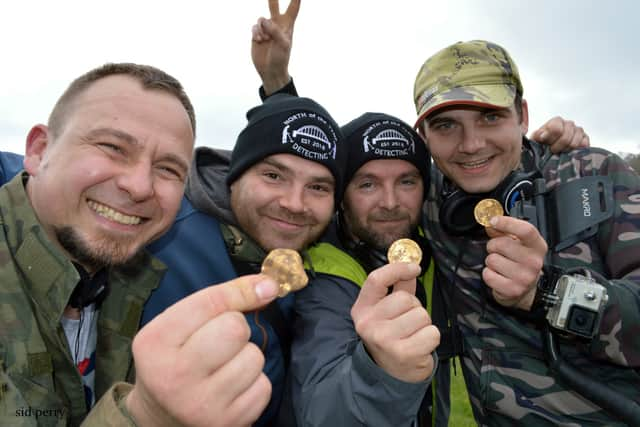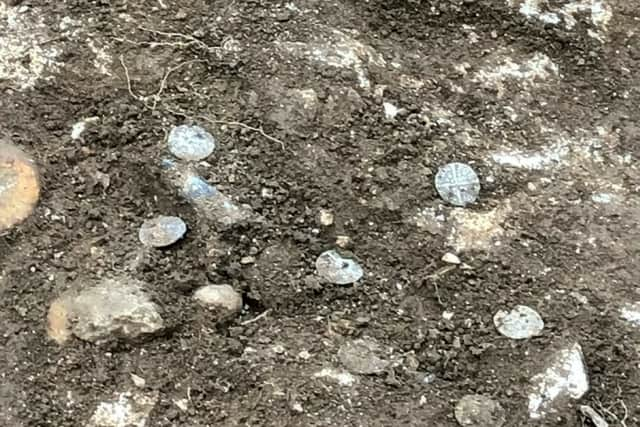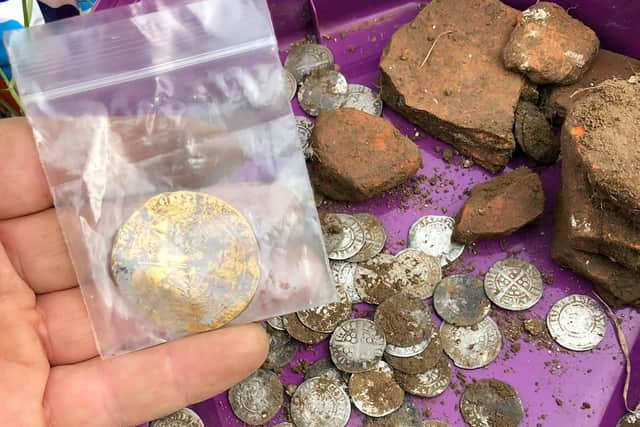Bristol dad-of-three among group of detectorists to find £150k hoard of medieval coins
and live on Freeview channel 276
A hoard of 600 medieval coins found by amateur detectorists including a Bristol dad-of-three has been declared treasure.
The £150k hoard - believed to be the biggest found in decade - was found by a group of amateur detectorists including Bristol machine operator Dariusz Fijalkowski.
Advertisement
Hide AdAdvertisement
Hide AdSeven men found the coins on the Culden Faw Estate, Buckinghamshire, in April 2019 - including 12 rare gold nobles from the reign of Edward III. Their finds — nicknamed the “Hambleden Hoard” — represent the biggest gold and silver collection found in the UK for around a decade.
The men - more used to digging up shotgun shells and thimbles than treasure - were astonished to find coin after coin from the hidden ancient hoard. Over four days they excavated 627 coins - including 12 ultra-rare full gold nobles from the time of the Black Death.
The hoard was unearthed by Dariusz along with Andrew Winter, Dom Rapley, Eryk Wierucki, Jaroslaw Giedyna and brothers Tobiasz and Mateusz Nowak. They even slept in a tent by the hole to stop thieves during the dig.
At an inquest last week, senior coroner Crispin Butler said the hoard met the criteria for treasure after reading a report by Dr Barrie Cook, a curator at the British Museum.
Advertisement
Hide AdAdvertisement
Hide AdMr Butler described the 12 gold nobles from 1346 to 1351 as extremely rare with only 12 known examples found during a 1963 survey.


The rest of the hoard — 547 silver pennies from the reigns of Edward I and II, 21 Irish pennies, 20 continental coins and 27 Scottish pennies from the reign of Alexander III, John Balliol, and Robert the Bruce — were more commonly found.
It will now be left for the museum to negotiate a settlement with the finders and landowners, none of whom was present at the hearing. Dariusz came across the hoard after he had been “delighted” with a thimble he’d found. He then found two silver coins before teaming up with the other men and added: “Special for me was two silver coins. Before that - apart from the thimble - it had been shotgun shells.
“When I found the coins I was shouting so much because I was so excited.
Advertisement
Hide AdAdvertisement
Hide Ad“Maybe I should have stayed quiet but I was so happy. For me those coins alone were special. They are small pieces of silver and also a piece of history.
“But to see what we found in the end. I still can’t believe it. I came away to the rally for a rest because I have three young children. It’s safe to say it was not rest. I can still feel the pressure now. It’s incredible.”


The find was made at an organised rally which was held on a field near Hambleden, a village recorded in the Domesday Book of 1086.
Pals Andrew, Tobiasz and Mateusz spent an hour digging on a field without finding anything, and were on their way to another location when their detectors signalled.
Advertisement
Hide AdAdvertisement
Hide AdAndrew, a forklift and crane driver, said his machine was emitting a code which suggested they had detected a hammered silver coin - so he started digging.
The trio turned over a clod of earth which contained two coins, and could see more in the hole. It happened around at the same time as then-stranger Dariusz, found two silver coins.


Under the rules of detecting and treasure finding, anything over three coins is considered a ‘hoard’ - meaning it has to be declared to organisers. The area was cleared and claimed jointly by the team who were then left to work alone. They admit it got “absolutely hectic” when news of the find got round the festival.
Detectorists from all over the world who were at the festival came to take a look, as the four due out coin after coin. On the first day they found 276 silver coins and nine gold nobles, and all admit they barely slept due to excitement.
Advertisement
Hide AdAdvertisement
Hide AdOver three days the team’s hoard grew to 545 silver coins plus fragments, and 12 gold nobles. Some of them have been doing the hobby for less than a year at the time. Anni Byard, finds liaison officer for the areas was called to oversee the excavation and the location of each coin was painstakingly plotted on a grid.
At the time the men said it would later be independently evaluated before being sold, with the value split with the landowner.
Comment Guidelines
National World encourages reader discussion on our stories. User feedback, insights and back-and-forth exchanges add a rich layer of context to reporting. Please review our Community Guidelines before commenting.
